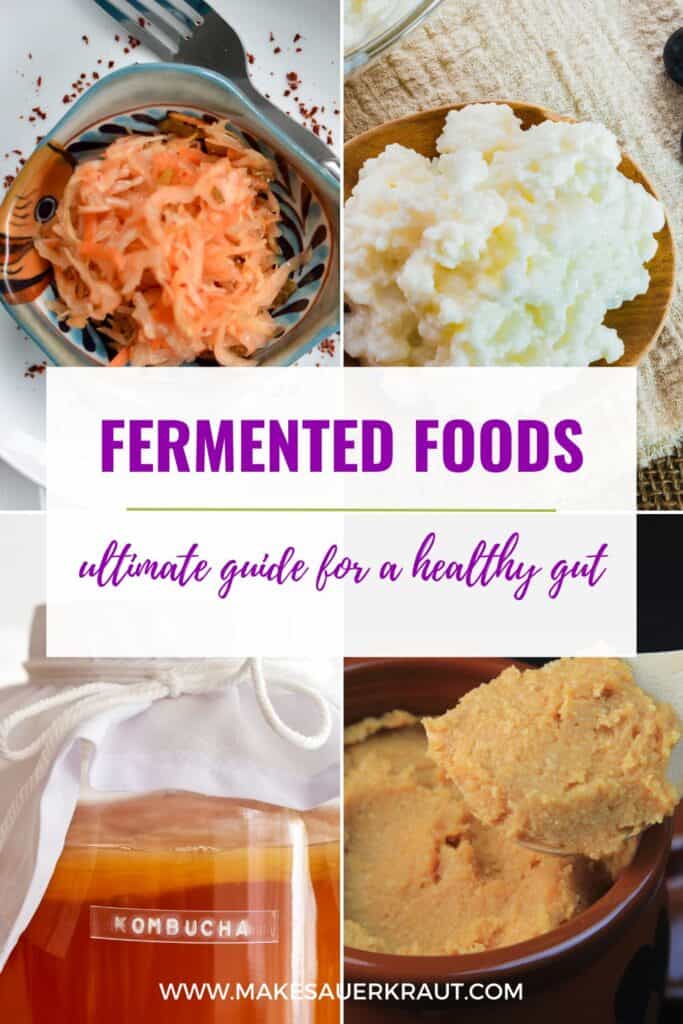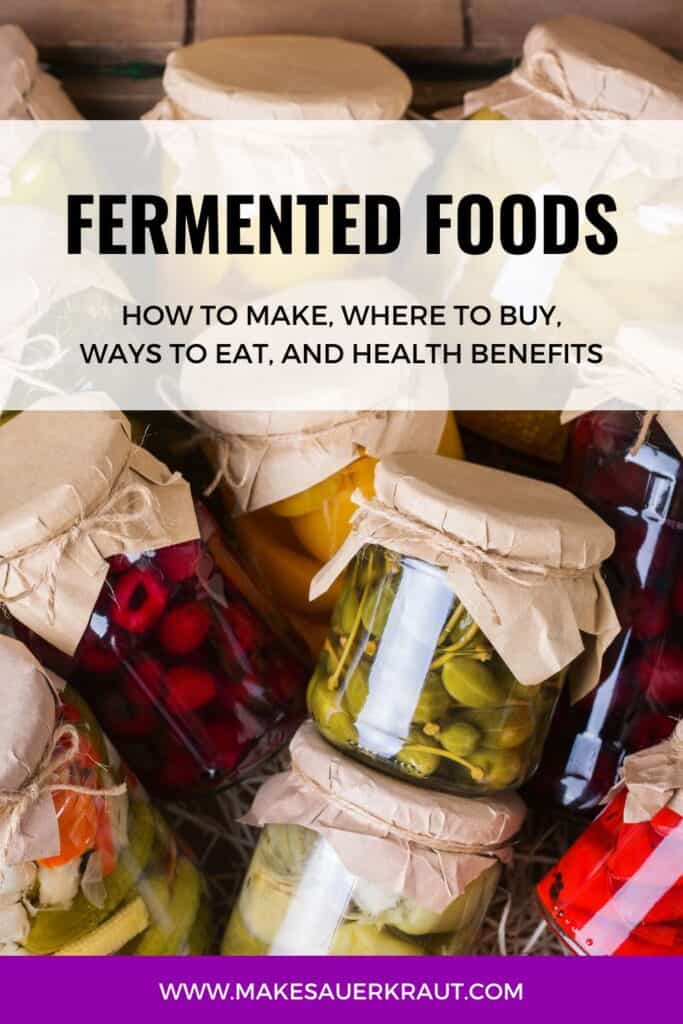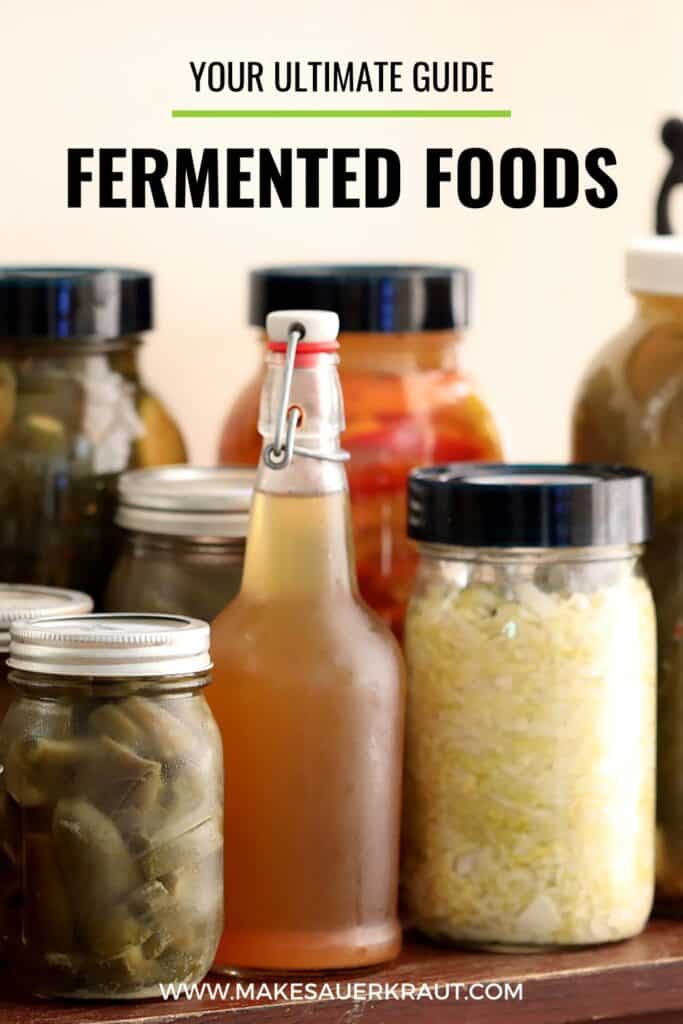Unlock the nutritional benefits of fermented foods with this complete guide. Learn about the different types, how to make them at home, and delicious ways to incorporate them into your meals.
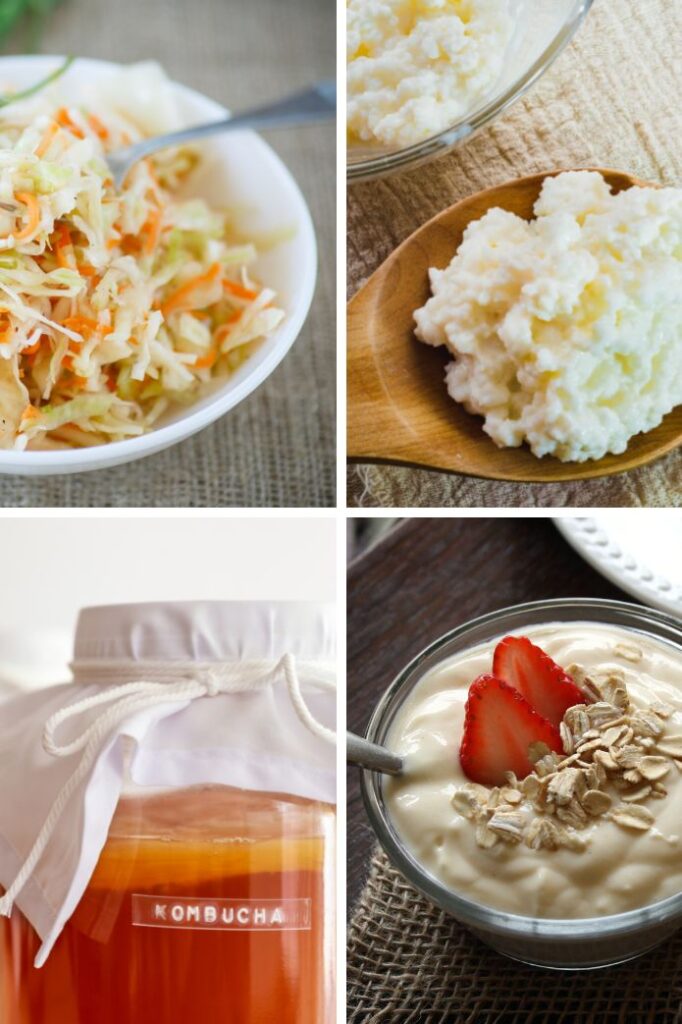
In this fermented food list, discover five fermented foods that are easy to incorporate into your diet for improved health.
Learn what to look for when purchasing to get the best “Bacteria Bang for your Buck.” Test simple recipes to make your own and save big money.
My “Ways to Eat” sections show how easy it is to add these powerful fermented foods to your diet and learn about their wonderful health benefits.
Let’s get started.
Fermented Foods are Ancient
Humans all over the world have used fermentation as a way to preserve their food since ancient times.
It is an awe-inspiring process that changes grapes into wine, barley seeds into beer, milk into cheese (or yogurt or kefir), flour into sourdough bread, soybeans into miso (or soy sauce), cacao beans into chocolate, pig into prosciutto, cucumber into pickle, and cabbage into sauerkraut or kimchi.
Through fermentation, not only is food preserved but it is made more nutritious and easier to digest. Virtually, every early society ate and enjoyed fermented foods.
However, with the advent of industrialized food processes, many fermented foods either were lost or are now made using vinegar and high-heat pressure processing or pasteurization.
These modern foods are missing powerful probiotics and beneficial enzymes of traditionally fermented foods. Crucial components for improved gut health.
The Health of Your Gut Microbiome is Key
It is only today that we are beginning to understand the power of including fermented foods in your diet. The Human Microbiome Project was launched in 2008, with the goal of identifying the microorganisms both in and on us and their impact on our health. This project and other studies are revealing many of the ways in which our invisible residents shape our lives, from birth to death.
Your body plays host to trillions of microscopic visitors that make up your unique microbiome fingerprint. A troop of bacterial superheroes living in your gut works very hard to help keep you healthy, strong, and resilient.
Watch this 3-minute video by the Canadian Digestive Health Foundation on the human gut microbiome and learn more about the superheroes that live within you.
Note: It is great that educational grant money was available to produce this video. We know who funded this video by the ad displayed at the end. However, as you read further, you’ll understand why the yogurt mentioned is not a brand recommended for building healthy gut bacteria.
Health Benefits of Fermented Foods
In Wild Fermentation, Sandor Katz cites a 2006 study that looked at the consumption of fermented foods and their impact on immune health.
Researchers looked at individuals who ate many kinds of fermented foods, such as sauerkraut, yogurt, pickles, and cheese.
After recording a baseline for immune function, subjects were placed on a diet without fermented foods and immunity markers plummeted. Then researchers fed one group regular yogurt, and another group probiotic-enhanced yogurt.
The probiotic group did a bit better, but it wasn’t until subjects were allowed to resume their normal diets with a wide variety of fermented foods and beverages that the highest levels of immune function returned.
“How I interpret that data is that diversity is its own reward,” Katz said. “Better than billions of copies of a single bacteria or two bacteria for stimulating immune function is ingesting foods with many different types of bacteria on them.”
All diseases begin in the gut– Hippocrates, over 2,000 years ago
– Hippocrates, over 2,000 years ago
We are only now beginning to understand how right he was.
Here are seven reasons to start including fermented foods in your diet:
1. Fermented foods are an excellent source of probiotics.
By consuming a variety of fermented foods, you are introducing beneficial bacteria to your gut, which can help to promote the growth of healthy microorganisms in your intestines. This, in turn, leads to improved digestion and better overall health.
2. Fermented foods have greater nutritional value.
The fermentation process makes the nutrients more bioavailable. For example, sauerkraut contains 20 times the bioavailable amount of Vitamin C than raw cabbage. Increased Vitamin C levels build health.
Captain Cook’s crew were free from scurvy on their sea voyages because they ate sauerkraut.
During the Civil War, physicians were able to reduce the death rate from disease among prisoners of war by feeding them sauerkraut.
3. Eating fermented foods leads to better absorption of nutrients
By consuming a variety of fermented foods, you are able to restore gut health.
Having a healthy balance of gut flora and plenty of digestive enzymes ensures that you will absorb more of the nutrients in the foods you eat.
4. Fermented foods support your immune system.
Most people, and many physicians, do not realize that 70 percent of the cells that make up your immune system are found in the walls of your gut.
By eating fermented foods, you enhance your gut flora and increase the number of beneficial bacteria present, which are then better able to ward off the invaders.
5. The fermentation process reduces the sugar content of foods.
During the fermentation process, bacteria use sugar as fuel to do their work. They eat the sugar for you!
During the fermentation of kombucha, the bacteria and yeasts in the added culture eat the sugars in the sweetened tea and produce a slightly sour drink.
During the fermentation of sauerkraut, the sugars present in the cabbage are consumed by the bacteria and the result is sauerkraut with a sour tang.
For wines and hard ciders, yeast present on the fruit help to ferment sugars into alcohol.
6. Fermentation safely preserves foods.
During the fermentation process, bacteria produce lactic acid, a preservative. This acidic fermentation renders foods resistant to spoilage and highly unlikely to develop food toxins.
This ancient art of fermentation has allowed cultures around the world to preserve and store food from the time of harvest to the time of consumption long before there were refrigerators, freezers, or canning.
7. Fermented foods are budget-friendly and… delicious!
Kombucha, which easily sells for $5.95 a bottle, can be brewed for the cost of seven black tea bags and one cup of white sugar.
One quart of sauerkraut kraut can happily ferment on your countertop for the cost of a two-pound head of cabbage, a couple of carrots, a few cloves of garlic, and a tablespoon of salt. Those are real savings that add up to a decent chunk of money over time.
And, oh, the flavor profiles that are developed during the fermentation process! Tangy sauerkraut, spicy Kimchi, sour yogurt and kefir, miso, effervescent kombucha, and lovely sweet chocolate are just a few of the many fermented foods to choose from.
Fermented foods are essential for your digestive health. Make it our long-term goal to eat a variety of bacteria-rich foods, so that your gut microbiome is made up of a wide range of beneficial bacteria.
Here are the five fermented foods to consider adding to your diet to improve your gut health. They are generally easy to find or make and are simple to add to your diet. Pick one to start with.
- Sauerkraut & Kimchi
- Yogurt
- Kefir
- Miso
- Kombucha
Sauerkraut & Kimchi

Sauerkraut, fermented cabbage, is a popular condiment, most famous as a topping on hot dogs.
The word “sauerkraut” is German for sour white cabbage. Cabbage by itself offers benefits, but it is through the fermentation process that the bioavailability of nutrients is increased making sauerkraut even more nutritious than the original cabbage.
Sauerkraut is made by mixing sliced cabbage with salt and packing the mixture into a crock or jar. It is then left to ferment at room temperature, for anywhere from one week to eight weeks.
Kimchi—the national dish of Korea, often eaten at every meal—is made with Napa cabbage, ginger, garlic, onions, radish, and spicy red pepper.
Koreans consume 1.5 pounds of kimchi per week! That’s almost a 1-quart jar of sauerkraut, every week, per person. Americans consume 1 quart annually.
Health Benefits of Sauerkraut
Lacto-fermentation of cabbage into sauerkraut results in many positive health benefits. Here are three reasons to start eating sauerkraut with more benefits of sauerkraut here:
- Sauerkraut is rich in probiotics. Probiotics enhance your digestion, help heal any damage to the digestive tract and boost your immune system and energy level.
- Sauerkraut has great nutritional value. The fermentation process actually predigests the food, making the food more digestible and the nutrients more bioavailable.
As Dr. Natasha Campbell McBride explains:
“In fresh cabbage, vitamin C is bound in the cellulose structure and various other molecules, and our digestive system is just not able to cleave it off and absorb it. Lots of it goes undigested and comes out right out of you… But if you fermented that cabbage and made sauerkraut, all the vitamin C becomes bioavailable,” - Sauerkraut has anti-cancer properties. The cabbage used in the fermentation process contains glucosinolates, found in all cruciferous vegetables, that have been shown in laboratory research to have anti-cancer activities.
These glucosinolates are destroyed by cooking and pasteurization
Sauerkraut or Kimchi Shopping Guide
To obtain the health benefits of traditionally fermented sauerkraut, the sauerkraut you purchase must be raw and not contain vinegar.
- Look in the refrigerated section of natural foods stores. Canned sauerkraut down an aisle is pasteurized.
- Look for the words unpasteurized, or raw on the label.
- Ingredients should be only cabbage, salt, and whatever vegetables are used for seasoning.
- Vinegar should not be listed.
- You might find “starter culture” on the label, which is fine. Some companies use a starter culture to boost the number of beneficial bacteria present at the beginning of the fermentation process.
For additional tips see my detailed post: Sauerkraut Shopping Guide [Buy the Right Stuff]
Buy the Right Stuff! FREE Download
Use the button below to get your own printable Sauerkraut Shopping Guide.
How to Make Your Own Sauerkraut: Tips and Links
Learning to make sauerkraut is perfect for your first foray into fermentation. No fancy jars are required. No expensive equipment, though I do recommend a scale to ensure proper salt levels.
Just cabbage, salt, and time, which can be as little as 7 days, though the best levels of beneficial bacteria are achieved after 20 days! It keeps well and will save you oodles of money over buying the expensive stuff at the store.
My recipe, How to Make Sauerkraut In a Jar [THE COMPLETE GUIDE] is not “just a recipe,” but instead a mini fermentation course in which I teach you everything you need to know to successfully ferment sauerkraut using a jar and other items found in your kitchen.
My proven tips, step-by-step photos, and helpful notes have you covered.
Sauerkraut can be made with carrots, beets, or flavored like kimchi. I have also canvassed the internet for this sauerkraut recipe round-up.
Ways to Eat Sauerkraut
The texture and flavors of sauerkraut go well with any dish. Check out these easy ways to eat sauerkraut.
Or visit my ever-growing list, 33 Easy Ways to Eat Sauerkraut That Will Have You Craving More for more inspiration.
- Alongside any meal. A forkful or two of sauerkraut will bring out the flavors and aid in digestion, especially protein and fats.
- On a sandwich or hot dog: Sauerkraut adds a tangy, crunchy texture to sandwiches and hot dogs.
- As a topping for grilled meats: Sauerkraut can be used as a topping for grilled meats such as pork or sausage.
- In a salad. Fermented cabbage can be added to salads for a tangy, crunchy contrast to the greens.
- To add a zing to eggs: Top scrambled eggs or add sauerkraut to an omelet. Kimchi-style sauerkraut and top it with sour cream. Yum!
- Sandwich. Make a boring sandwich scrumptious by adding a nice layer of fermented cabbage to it.
To enjoy the beneficial enzymes and probiotics in sauerkraut, don’t heat it. Instead, add after your dish is cooked.
Yogurt
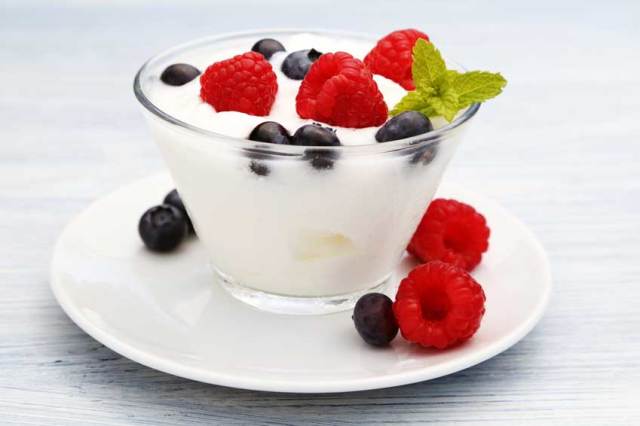
Yogurt is a popular, well-known fermented milk product made most commonly from cow’s milk, but also from goat’s milk and sheep’s milk.
The word yoğurt is Turkish in origin and related to the verb yoğurmak: “to be curdled or coagulated; to thicken.”
Yogurt is made by heating milk to a specific temperature to kill off any bacteria, then cooled and a starter culture of bacteria is added.
The mixture is then incubated at a warm temperature for several hours to allow the bacteria to ferment the lactose in the milk and produce lactic acid. This process thickens the milk and gives it a tangy flavor.
Health Benefits of Yogurt
The fermentation of milk into yogurt results in numerous beneficial changes. Here are four reasons to start eating yogurt:
- Yogurt is easier to digest than milk. The culturing of yogurt breaks down casein, a milk protein and one of the most difficult proteins to digest.
- Yogurt is rich in valuable enzymes. The culturing process for yogurt restores many of the enzymes destroyed during pasteurization including lactase, which helps to digest the lactose, or milk sugar, inherently present in the milk.
- Yogurt is rich in vitamins. The culturing of milk increases the bioavailability of calcium, along with the vitamin C and vitamin D content of the milk.
- Yogurt contains probiotics. Yogurt introduces probiotics, or beneficial bacteria, into your digestive system and helps restore the balance of bacteria in your digestive system.
Yogurt Shopping Guide
If you’re eating yogurt to help optimize your gut flora, be careful that the yogurt you’re consuming does not more closely resemble candy than the cultured milk our ancestors ate.
Full-fat yogurt without sweeteners or additives delivers the greatest health benefits.
- Look for “whole” milk or “full fat” milk, meaning the cream has not been removed.
- You should see “live” or “living” bacteria or culture strains. This is the culture that is added after the milk is pasteurized.
- No harmful additives, such as high fructose corn syrup, colorings, preservatives, thickeners, or powdered milk.
- Plain, unflavored yogurt. To avoid preservatives and sweeteners, flavor enhancers, thickeners, and stabilizers, add your own fruit and sweeteners.
- Avoid carrageenan, a “natural” food additive linked to gastrointestinal symptoms, used as a thickener and emulsifier to improve the texture of ice cream, yogurt, and other processed foods. Carrageenan, How a “Natural Food Additive is Making Us Sick.
Food industry well-kept secrets.
To thicken yogurt, it is common practice to add powdered milk during the commercial yogurt-making process. The thickener does not have to be added to the ingredient list since it is a “milk” product.
When dehydrating milk, commercial high-heat dehydration methods oxidize the cholesterol in the dehydrated milk, rendering it harmful to the arteries.
How to Make Your Own Yogurt: Tips and Links
I make yogurt not only to save money but because of its clean flavor and the ability to add my own sweetener and toppings. Also, I can make it with fresh, grass-fed milk, rich in omega 3s.
See Realmilk.com to locate grass-fed, raw milk for making your own yogurt. You can also make nutritious yogurt with whole, non-homogenized milk and even coconut milk.
I struggled with getting the right consistency with my homemade yogurt. It often turned out sour and runny until I read this in Wild Fermentation by Sandor Katz:
I used to use more starter, assuming that more is better, until I consulted my number one reference book, The Joy of Cooking (1964 edition), known affectionately as ‘Joy’ in our kitchen. ‘You may wonder why so little starter is used and think that a little more will produce a better result. It won’t. The bacillus, if crowded, gives a sour, watery product. But if the culture has sufficient Lebensraum [Germen for ‘room to live’], it will be rich, mild and creamy.
Now I add less than one tablespoon of starter—yogurt from a previous batch—to one gallon of milk.
I like to culture mine right in my quart canning jars and incubate either in my dehydrator or in a cooler filled with warm water bottles.
Here are a few yogurt recipes to check out:
Instant Pot Yogurt #12, Pressure Cooker Recipes. Make smooth, creamy & thick homemade yogurt with this yogurt recipe based on 12 experiments.
Easy 2-Ingredient Coconut Yogurt, Minimalist Baker. No fancy tricks or expensive equipment. Just 2 simple ingredients: coconut milk and probiotic capsules.
How To Make Yogurt at Home, The Kitchen. Cultured in your oven using a Dutch oven. No special heirloom yogurt cultures or fancy incubating equipment.
Ways to Eat Yogurt
Here are a few of my favorite ways to eat yogurt:
- As a breakfast or snack: Yogurt can be eaten plain or topped with fruit, granola, or nuts for a healthy breakfast or snack.
- In a smoothie. Yogurt can be added to smoothies for added protein and creaminess.
- As a dip: Yogurt can be seasoned and then used as a dip for fruits, vegetables, crackers, or pita chips.
Kefir

Kefir is a cultured beverage made from milk fermented with kefir grains.
This bubbly drink is a tart cousin to yogurt and originated more than 2,000 years ago in the Caucasus Mountains of Europe. The word Kefir originates from the Turkish word “keif,” meaning “good feeling.” Think of Kefir as a drinkable yogurt with a much greater range of beneficial bacteria than commonly found in yogurt.
Homemade kefir has between 30 and 56 strains of good bacteria, while yogurt has only 7 to 10. And the types of bacteria in kefir are also quite different from those in yogurt. The bacteria in yogurt pass through the body within 24 hours, their main purpose is to sustain the good bacteria that already reside in the digestive system. Kefir, however, is a source of those good bacteria. The bacteria in kefir stay and take up residence, creating a colony that remains in the digestive system.
In addition, unlike most other dairy ferments that use a culture from a previous batch to start the fermentation process (yogurt, sour cream, buttermilk), the fermentation of kefir relies upon kefir ”grains.” They are not truly a grain but a grain-like mass of bacterial and fungal cells that grow together into a white clump resembling little cauliflower florets.
Donna Schwenk, Cultured Food for Life
To make kefir, you simply add kefir grains to milk and leave at room temperature until thickened to your liking, about 24 hours.
It is a much simpler process to make kefir than yogurt because you do not have to heat the milk or incubate it at a special temperature during the fermentation process.
Health Benefits of Kefir
The culturing of milk into kefir results in numerous beneficial changes. Here are five reasons to start consuming kefir:
- Kefir has more strains of beneficial bacteria than yogurt. The cause of kefir grains in the culturing process results in a much broader range of probiotic strains than yogurt.
- Kefir is a rich source of many different vitamins, minerals, and essential amino acids. These nutrients help with general health maintenance, promote healing and repair, and boost the assimilation and utilization of carbohydrates, fats, and proteins.
- Kefir is easy to digest. The fermentation process partially digests the proteins in milk, allowing your body to assimilate the proteins.
- Kefir is lower in sugar than yogurt. The milk sugars are predigested by the fermentation process, making kefir extremely low in sugar. Kefir is 1% sugar while yogurt is 4% sugar.
- Kefir helps control blood sugar levels. The fermentation of kefir results in high levels of lactic acid and enzymes that regulate sugar metabolism.
Kefir Shopping Guide
Commercially available kefir is made from a laboratory-created culture that is added to the milk and then fermented. This is not the same as kefir cultured with kefir grains and will not impart the same health benefits.
If you’re going to drink kefir for its health benefits, learn to make your own, which is a very simple process.
If you do purchase kefir, make sure the kefir you purchase contains just milk, ideally full fat, and live cultures and no other harmful additives.
How to Make Your Own Kefir: Tips and Links
To make your own kefir, you first need to obtain the kefir grains. Here are some ways to find a local source willing to share their kefir grains:
- Staff at your local health food store may be culturing their own kefir and will have grains to share.
- Search your online local used circuit or fermentation Facebook groups in your area.
- Locate a local chapter of the Weston A. Price Foundation, a non-profit educational group dedicated to restoring nutrient-dense foods.
Some online sources for purchasing kefir grains:
Kefir Garden (Canada): “Our Milk Kefir Grains are extremely hardy and always fresh. Each order is packed with a little organic milk for their journey to your home.”
Freshly Fermented (UK): “CONTAINS THE HIGHEST NUMBER OF BACTERIA AND YEASTS FOUND IN ANY OF OUR CULTURES.”
Yemoos Nourishing Cultures. Genuine kefir has been made traditionally for hundreds of years and is not the same as commercial or powder starter kefir.
Here are a few kefir recipes to check out:
Cultured Food for Life. Donna Schwenk is quite passionate about kefir and has seen amazing health results with the inclusion of kefir in her diet and her client’s diets. Her website contains many ways to use kefir and many troubleshooting tips on making kefir.
MILK KEFIR STEP-BY-STEP GUIDE, Yemoos.
The ULTIMATE Milk Kefir Guide (how to make it, troubleshooting tips & MORE!), Traditional Cooking School.
Most recipes have you strain the thickened milk to separate the grains from the milk. I find that the milk is too thick to readily run through the strainer. Instead, I use my hand to pull the grains out, and then I just put them in a new jar with fresh milk for the next ferment.
Ways to Enjoy Fermented Kefir
Here are a few of my favorite ways to enjoy naturally fermented kefir:
- As a drink: Fermented kefir can be enjoyed as a refreshing drink on its own, or with added fruit or honey for sweetness.
- In smoothies: Kefir can be added to smoothies for a tangy, creamy texture and added probiotics.
- As a dressing: Kefir can be used as a dressing for salads or as a dip for vegetables and crackers.
- On hor or cold cereal: Kefir will add a tangy and creamy flavor to the cereal, and also provides a boost of probiotics.
Miso

Miso (pronounced mee-so), a traditional Japanese high-protein seasoning, is a thick salty paste full of umami and is used to flavor everything from soups to marinades and salad dressings.
Its widespread use in Japan and China dates back centuries. Today, it is a favorite of health-minded people in the West due to its many health benefits.
While it was once thought that the consumption of soy in Asia was responsible for their low rates of heart disease and breast cancer, more evidence is showing us that the consumption of traditionally fermented soy products is providing real benefits.
Miso is made by mixing pureed cooked beans with a miso starter (purchased unpasteurized miso, or miso from a previous batch), koji (a grain inoculated with the mold spore responsible for the actual fermentation process), and salt.
This mixture is packed into a fermentation vessel, weighted down, covered with cheesecloth, and left to ferment for anywhere from six months to two years.
Health Benefits of Miso
The fermentation of soybeans into miso results in numerous beneficial changes. Here are three reasons to start eating miso:
- Miso offers protection against radiation. A variety of enzyme-rich compounds found in miso assist in detoxifying and eliminating industrial pollution, radioactivity, and chemicals.
- Miso is antiviral. Miso is very alkalizing to power your immune system and fight off any viral infections.
- Miso is rich in vitamins and minerals. Miso contains a full nutritional profile, with especially high levels of beneficial vitamin B12. Miso is also a very good source of manganese and copper as well as zinc
Miso Shopping Guide
The type of miso you purchase will depend on personal taste as well as intended use.
Darker-colored miso is stronger and more pungent in flavor, it is generally better suited for heavier foods. Lighter-colored miso is more delicate and oftentimes more appropriate for soup, dressings, and light sauces.
- Look for raw or unpasteurized on the label.
- The label should also indicate traditional fermentation methods.
- Organic.
- Between six months and two years for the fermentation time. Soy protein is hard to digest. A long and slow fermentation breaks down the proteins in the beans.
Miso keeps forever. This is what South River Miso says about their miso:
South River Miso is technically not a perishable food, and we are not required to put an expiration date on our product. Whether opened or unopened, South River Miso will keep almost indefinitely – even for years. Indeed, we have kept some miso for as long as 20 years without spoilage, even without refrigeration. As with all foods, let your nose be the final judge.
How to Make Your Own Miso: Tips and Links
I have not fermented my own miso, but I researched this topic and discovered that miso is easy and satisfying to make at a fraction of the cost of store-bought brands.
How to Make Miso (The Ultimate Guide), Revolution Fermentation. With only four ingredients, a few minutes of preparation, and lots of patience, you can make this tasty miso paste.
HOW TO MAKE MISO: IT’S FUN AND SATISFYING!, Fermenting for Foodies. Wondering about how to make miso? It’s actually easier than you expect!
HOMEMADE MISO RECIPE, MADE WITH GARBANZO BEAN INSTEAD OF SOY, Superfood for SuperHealth. Basic step-by-step guide for making miso paste from scratch and culturing it between 6 months to a year.
Miso years are calculated by the number of summers it has aged. So, if you have gone through one summer of fermentation, then you have one-year-old miso, technically speaking. But on average, it should ferment at least 5-6 months for the flavors to really mature.
Ways to Eat Miso
Miso is a versatile food that can be eaten in a variety of simple ways.
- In a dressing. Combine miso with olive oil, freshly grated ginger, finely minced garlic, and a squeeze of lemon and drizzle on your favorite salad, pasta dish, or cold grain salad.
- As a nourishing drink. Stir into warm water and sip to your heart’s content. What could be easier?
- As a spread: Miso paste can be used as a spread for sandwiches or crackers, similar to peanut butter, tahini, or cream cheese.
- In miso soup. Miso soup is a traditional Japanese dish made by dissolving miso paste in dashi broth and adding various ingredients such as tofu, seaweed, and green onions.
Like most fermented foods, the beneficial bacteria in the miso are destroyed by heat.
If making a hot drink or soup, stir it in just before serving, and once it has cooled to the temperature at which you can hold your finger in the liquid for a few moments. If it doesn’t burn your finger, it won’t kill the good guys
Kombucha

It is widely believed that Kombucha originated in China around 220 BC. The Chinese called it their “Tea of Immortality” and drank it before going into battle.
Kombucha is made by fermenting sweetened tea with a culture (kombucha from a previous batch of fermented tea) and a SCOBY (a symbiotic culture of bacteria and yeast) to produce an effervescent drink said to help the digestive system and detoxify the body.
Kombucha does contain alcohol though in small amounts (between .5% and 3%) and dependent upon the fermentation conditions. (Beer contains 4-6% alcohol.)
Health Benefits of Kombucha
Kombucha contains fewer calories, carbohydrates, and sugars, and is free of preservatives. The fermentation process also results in several benefits:
- Kombucha helps your digestive system. High levels of probiotics and enzymes are responsible for supporting digestion.
- Kombucha works to detoxify the body. Again, high levels of probiotics, along with gluconic acid, a powerful antioxidant responsible for liver detoxification, help remove toxins from your body.
- Kombucha may improve mental health. Kombucha contains antioxidants and other compounds that may help reduce stress and improve mood.
Kombucha Shopping Guide
Some companies pasteurize their kombucha for shelf stability, to allow shipping without refrigeration, and to maintain a very low alcohol level. Others, don’t use traditional fermentation techniques to build carbonation and instead add the CO2 gas during bottling.
Unpasteurized kombucha brewed using traditional methods is best.
- Head to the refrigerated section. Shelf-stable kombucha contains no more beneficial probiotics.
- Select glass bottles over aluminum and plastic. Kombucha is naturally acidic, which means it can break down aluminum and plastic. Glass is non-reactive.
- Look for the words “raw” or “unpasteurized” on the label.
- Whole food flavoring (sliced ginger, rose petals, etc. is preferred over “natural flavors.”
- Cloudiness or floating particles left behind by the yeasts and bacteria that as part of the natural fermentation process.
- Avoid brands that list “carbonated water.” The kombucha brewing process naturally creates carbonation.
- Choose local when possible.
How to Make Your Own Kombucha: Tips and Links
If you drink kombucha daily, learn to make it yourself to save money. It’s as simple as making a pot of tea.
Like kefir, the greatest hurdle is obtaining the liquid starter tea and culture, or SCOBY.
The liquid starter tea is kombucha from a previous batch and the SCOBY (“Symbiotic Culture of Bacteria and Yeasts”) is a creamy-white gelatinous disk that grows during the fermentation process.
Here are some websites that can send the liquid starter tea and SCOBY right to your front door. I would stay away from freeze-dried cultures, which many have not had success with.
HOMEMADE KOMBUCHA RECIPE, Cultures for Health.
How to Make Kombucha At Home, The House and Homestead.
Kombucha Kamp is well known and owner Hannah Crum travels the nation sharing her skills at workshops and fermentation festivals.
Get Kombucha sells starter kits and an online recipe that covers everything you need to know to successfully brew Kombucha at home.
Ways to Enjoy Kombucha
Like with any of the fermented foods, start slowly and see how your body reacts. Some notice detoxification symptoms. I drink 8 ounces a day, a small glass in the morning and another mid-afternoon.
- As a drink: For quenching my thirst on a hot summer day, nothing beats kombucha. I can gulp down glass after glass of water and still not feel refreshed. It’s the kombucha that hits the spot.
- As a hangover cure. According to Kombucha Brooklyn’s founder Eric Childs, “It’s the best damn hangover cure I have ever found.” “It has natural detoxifying properties like gluconic acid that targets the liver.”
- In cocktails: Kombucha can be used as a mixer in cocktails, to add a tangy, effervescent flavor.
- For an energy lift. When you’re looking for an energy boost, for me that’s mid-afternoon, sip a glass of kombucha. I find it clears my mind and “wakes” me up.
Which Fermented Food Are You Going to Add to Your Diet?
Share in the comment section, which one of these five fermented foods (sauerkraut, yogurt, kefir, miso, or kombucha) you are going to either learn to make or purchase and add to your diet.
Either use the supplied links or check out my selection of fermented food recipes.
Pay attention to any health or digestive changes you notice and come back later and share those changes.



 This post may contain affiliate links which won’t change your price but will share some commission.
This post may contain affiliate links which won’t change your price but will share some commission.